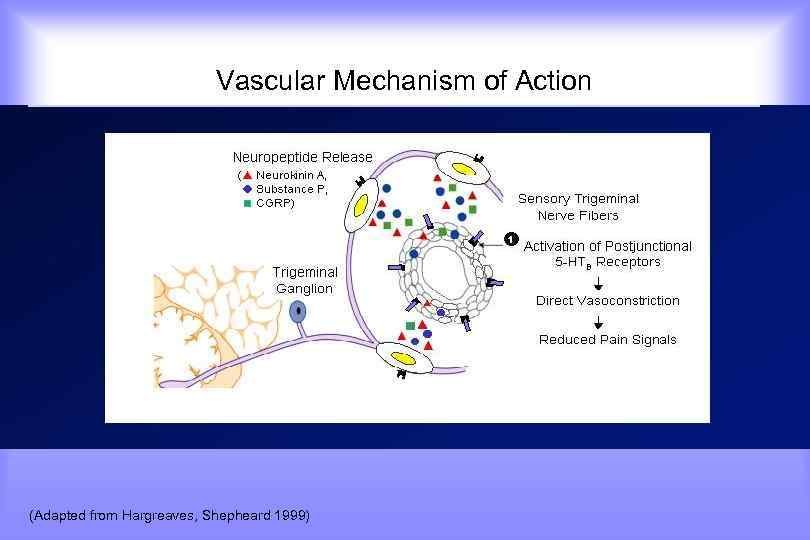 Pathophysiology of Migraine and Proposed Mechanisms of Action of Acute Therapies
Pathophysiology of Migraine and Proposed Mechanisms of Action of Acute Therapies
 Objectives • Review the proposed pathophysiological mechanisms of migraine • Describe the proposed therapeutic targets for acute anti-migraine agents
Objectives • Review the proposed pathophysiological mechanisms of migraine • Describe the proposed therapeutic targets for acute anti-migraine agents
 Migraine in the New Millennium
Migraine in the New Millennium
 CNS Activation During Migraine Copyright Permission Obtained Weiller, C, May, A, Limmroth, V, Nature Medicine 1995; 1(7): 658 -660, [http: //www. nature. com/nm] *Areas of red indicate cerebral blood flow increases (P <0. 001)
CNS Activation During Migraine Copyright Permission Obtained Weiller, C, May, A, Limmroth, V, Nature Medicine 1995; 1(7): 658 -660, [http: //www. nature. com/nm] *Areas of red indicate cerebral blood flow increases (P <0. 001)
 Capsaicin-Induced Cranial Pain Venous Sinus (May et al. 1998)
Capsaicin-Induced Cranial Pain Venous Sinus (May et al. 1998)
 Trigeminovascular Migraine Pain Pathways (Adapted from Hargreaves, Shepheard 1999)
Trigeminovascular Migraine Pain Pathways (Adapted from Hargreaves, Shepheard 1999)
 Acute Anti-migraine Targets (Adapted from Hargreaves, Shepheard 1999)
Acute Anti-migraine Targets (Adapted from Hargreaves, Shepheard 1999)
 Vascular Mechanism of Action (Adapted from Hargreaves, Shepheard 1999)
Vascular Mechanism of Action (Adapted from Hargreaves, Shepheard 1999)
 5 -HT 1 B/1 D Receptor Immunoreactivity in Human Cranial and Coronary Arteries (Longmore et al. 1998)
5 -HT 1 B/1 D Receptor Immunoreactivity in Human Cranial and Coronary Arteries (Longmore et al. 1998)
 Higher 5 -HT 1 B Receptor Expression in Human Meningeal vs Coronary Arteries (Longmore et al. 1998)
Higher 5 -HT 1 B Receptor Expression in Human Meningeal vs Coronary Arteries (Longmore et al. 1998)
 Neurogenic Mechanism of Action (Adapted from Hargreaves, Shepheard 1999)
Neurogenic Mechanism of Action (Adapted from Hargreaves, Shepheard 1999)
 Neurogenic Mechanism of Action • Neurogenic blood vessel vasodilation: Intravital microscopy in rat migraine model • 5 -HT 1 B/1 D agonists block release of vasoactive neuropeptides (CRGP) (Shepheard et al. 1999)
Neurogenic Mechanism of Action • Neurogenic blood vessel vasodilation: Intravital microscopy in rat migraine model • 5 -HT 1 B/1 D agonists block release of vasoactive neuropeptides (CRGP) (Shepheard et al. 1999)
 Human trigeminal Tract: CGRP Fibers Co-express 5 -HT 1 D Receptors
Human trigeminal Tract: CGRP Fibers Co-express 5 -HT 1 D Receptors
 Neurotransmitter Systems in Primary Headache (Adapted from Edvinsson, Goadsby 1998)
Neurotransmitter Systems in Primary Headache (Adapted from Edvinsson, Goadsby 1998)
 Plasma Neuropeptides and Headache *Normalized concomitant with pain relief after sumatriptan (Edvinsson, Goadsby 1998)
Plasma Neuropeptides and Headache *Normalized concomitant with pain relief after sumatriptan (Edvinsson, Goadsby 1998)
 Central Mechanism of Action (Adapted from Hargreaves, Shepheard 1999)
Central Mechanism of Action (Adapted from Hargreaves, Shepheard 1999)
 Human Dural Trigeminal Nerve and TNC: 5 -HT 1 D Immunoreactivity
Human Dural Trigeminal Nerve and TNC: 5 -HT 1 D Immunoreactivity